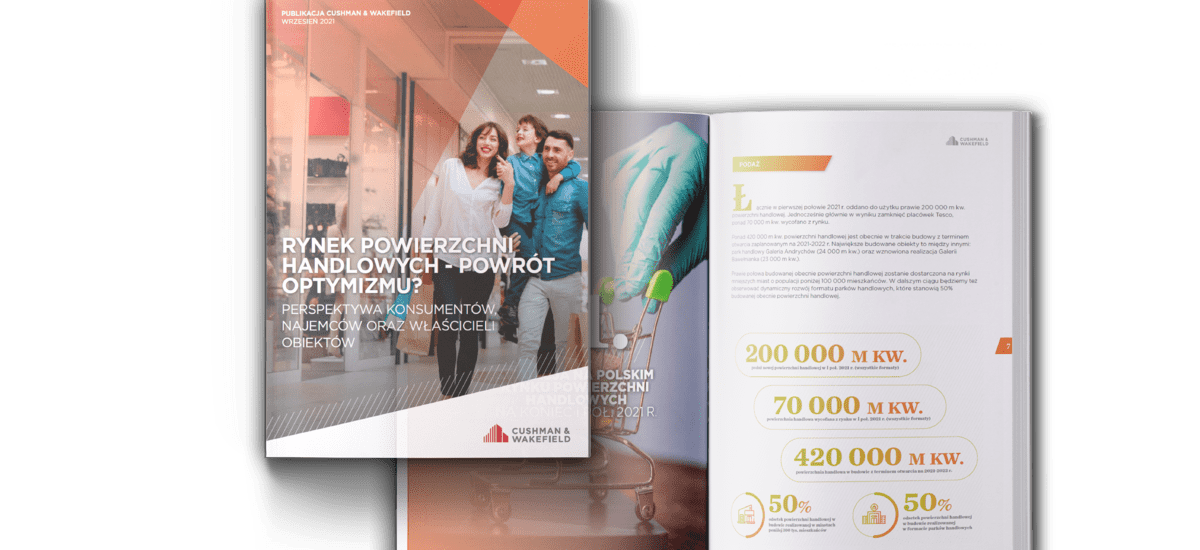

Bricks-and-mortar era is far from over. Polish retail market from the perspective of retail landlords
The redefinition of the Polish retail sector began well before the outbreak of the COVID-19 pandemic and was driven by the market entering into a mature phase amid growing saturation rates and wider changes to the behaviour and expectations of the present day consumer. The pandemic has accelerated this process and created a whole new environment which all retail market participants need to learn to navigate. Global real estate services firm Cushman & Wakefield has published a report “Is Confidence Returning to the Retail Market?”, whose key takeaways for landlords are given below.
Pandemic legal skirmish
The last year and a half has been challenging for both shopping centre landlords and tenants. The pandemic has thwarted many strategic business plans and lawmakers have made things worse by interfering in lease relationships, which drove an unnecessary wedge between market players. Nobody expected multiple lockdowns to be announced, and each caused considerable confusion and chaos. Financial distress worsened by the month amid administrative and legal disputes about leases. In the end, the confusion did not, however, impact landlord-tenant relationships as both parties began to discuss possible solutions irrespective of the Anti-Crisis Shield and agreed annexes with reduced rental rates in close to three-fourths of cases.
“Research has revealed that only around 3%-4% of store closures were due to the lack of an understanding between parties – they largely resulted from a typical restructuring of store portfolios that consisted in closing units that were unprofitable before the pandemic or were not line with a retailer’s concept,” says Paulina Bauer, Associate, Head of Retail Asset Services Poland, Cushman & Wakefield.
A dilemma, however, arose about whether to take court action against the State Treasury. More than 69% of the respondents to the survey (per GLA) say that they will not take court action and this decision stems mainly from their internal policies (25%). On the other hand, the owners of 29% of the surveyed GLA are already planning or are expressing an interest in joining a class action. Tension was additionally fuelled by the ambiguity surrounding the interpretation of enacted laws. Answers to the question about the interpretation of “a performance for the benefit of the landlord” as defined in legislation show how landlords differ in their interpretations. For more than 43%, it is rent plus service charges and marketing fees, for 40% – all charges invoiced to tenants, for 15% – only rent, and for 2% – rent and marketing fees.
“The situation is gradually returning to normal and as a result of the above crisis, landlords are now increasingly focused on how to operate in the future, i.e. how to support tenants in order to accelerate a return to pre-pandemic performance. Despite improving results, both parties continue to be affected by the consequences of the pandemic and have to look for compromises in very complicated negotiations of successive annexes to lease agreements,” concludes Beata Kokeli, Partner, Head of Retail Agency Poland, Cushman & Wakefield.
Not the last word
At some point a substantial proportion of the retail sector believed in the imminent demise of bricks-and-mortar retail. It seemed that shopping centre sales would never return to previous levels, but in fact online sales tend to rise whenever restrictions are introduced and fall sharply when eased. This shows that shopping centres have not said the last word yet and that, going forward, they will enjoy a new chapter in their history. However, not all retail schemes were equally attractive.
“Convenience shopping centres and retail parks where retail dominates are performing a lot better. The hardest hit are those in tourist or business destinations and large university cities. The same holds true for retail schemes with a strong leisure and F&B component. Retail facilities serving a local catchment have, however, emerged relatively unscathed,” comments Paulina Bauer, Associate, Head of Retail Asset Services Poland, Cushman & Wakefield.
Interestingly enough, the outlet sector is reporting decent footfall levels which were down by less than 20% compared to 2019, with a similar decline in turnover. 33% of the sector’s surveyed GLA reported similar or better results compared to 2019, which suggests the growing strength of outlet centres that are increasingly seen as visually and functionally appealing facilities that offer an enjoyable customer experience, frequently in the premium segment.
The holistic analysis of retail footfall and turnover levels has importantly revealed that conversion rates have increased during the pandemic. Conversion was higher than before the pandemic for 53% of the respondents (per GLA) or remained largely unchanged for 18%. The survey conducted in May, June and July 2021 shows that footfall levels were down by 20%-30% for 64% of the surveyed GLA, with similar or higher footfalls compared to the same period in 2019 for 22% of the surveyed GLA. As for turnover for the same periods, it held firm or increased compared to 2019 for 51% of the surveyed GLA. Another 21% of the respondents reported a decrease in turnover of between 10%-20%, while 28% recorded a drop of more than 20%. These levels of decline varied mainly by location and retail format.
Author:
Cushman & Wakefield
Last Updated on October 21, 2021 by Karolina Ampulska